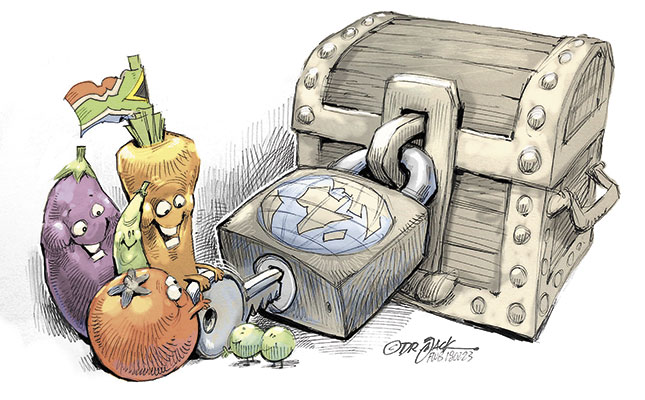
Photo: Dr Jack
As a result of rapid globalisation, a rise in the middle class that drives purchasing power, growth in youth populations, processed food becoming popular, and an increase in consumption, more and more local vegetables are being exported to Asia, the Middle East and some cities in Africa.
With this trend, world markets have become more and more dependable on production areas with accessible water and irrigation systems; these include South Africa and certain other African countries.
Inelasticity of demand in the South African market due to its limited size means that vegetable prices can easily become depressed when there is an oversupply. Therefore, for the local industry to grow, export markets must expand.
Expanding into Africa
Interviews with role players and a review of trade statistics suggest that the Southern African Development Community (SADC) countries are the largest recipients of local vegetable export products.
This is primarily because they have retail outlets.
Fresh produce gives formal retail outlets a competitive edge as they bring regular customers to centralised stores.
The expansion of South Africa’s retail chains such as Shoprite, Pick n Pay, Spar and Woolworths plays an important role in the cross-border trade of vegetables and fresh produce in general, and growing consumer spending is followed by investment growth in the formal retail sector of these markets.
In many African countries, spending by the middle class is expected to remain stagnant, but early evidence suggests a strong growth in spending by the lower middle class.
This will provide a basis for selling basic products such as starches, beer and vegetables.
Strategies for trade in Africa still aim at low-income consumers over the next five years; many South African retailers would benefit from positioning themselves for growth in the formal retail sector in Africa.
Market agents’ role
In contrast to fresh produce markets that have spot sales, most formal retailers source their produce through direct contracts with farmers, and so ensure quality and traceability.
However, the role of agent-based fresh produce markets remains as a market-clearing and price-finding mechanism.
Many informal traders also export to neighbouring countries via purchases at South African fresh produce markets.
With fresh produce markets mostly absent in Africa, South African market agents have a role to play in facilitating trade.
Trade barriers in Africa
Some African countries are hostile to South African exports of vegetables as they believe they cannot compete against our commercial production.
Farming in most African countries remains mostly small-scale, fragmented and unfunded, with the exception of countries such as Zambia and Kenya.
Many African countries also lack cold storage facilities, making it impossible to trade more perishable fresh produce.
South African investors can play a role in establishing cold chain facilities to make it possible for less hardy fruit and vegetables to be traded.
Sourcing from South Africa therefore still remains unavoidable.
There are many examples of neighbouring African countries restricting South Africa’s vegetable trade, particularly during their own growing seasons.
Angola applies prohibitive tariffs of about 50% on vegetables, and Namibia has local content requirements of between 50% and 60% on sourcing produce.
Botswana, Zambia and Zimbabwe often close their borders to protect local production against foreign competition.
In some African countries, payment carries risks and challenges due to currency problems and the lack of financial solutions.
Exporters require credit guarantees and letters of credit to ensure payment, especially when they export to African destinations.
Trade infrastructure needed
There are many complementary opportunities for development in Africa. Support services can be expanded to complement the development of seed and plant material.
There is room for investment in cooling and production facilities and equipment.
Markets and selling agents, management services and financial products can all be established, and economic and business information needs to be made available.
Investment opportunities in organised retail north of the SADC are opening up, and demand in Africa will gradually shift from staples to discretionary products over the next 10 to 20 years as the middle class grows.
Trade negotiators have to pay attention to creating more certainty and transparency across these multiple areas of trade and investment.
Some of South Africa’s neighbours, even those in the Southern African Customs Union (SACU), close their borders overnight in a non-transparent manner, with cost implications for businesses.
Less developed countries and developing countries often do not adhere to World Trade Organization rules.
This creates an unstable regional trading environment.
No protocols with China
In Asia, there is strong growth in the middle class, and South African vegetable exporters are gradually responding to this demand, with vegetables currently exported to destinations such as Hong Kong, Singapore, Malaysia and Indonesia, which have fewer phytosanitary requirements than others.
However, China’s fresh vegetable market has not been prioritised by the local vegetable industry or government, and no action to open the market has been initiated.
This is despite the fact that China is willing to receive South African fruit such as citrus, apples and table grapes, as well as maize and tobacco.
Although China is the most lucrative market in Asia, South Africa does not yet have the sanitary and phytosanitary protocols in place for exporting popular products such as onions, butternuts and sweet potatoes to this country.
The Jakarta port in Indonesia is now open to South African fruit and vegetable exports.
Transport costs are relatively cheap to Asian destinations compared with the very expensive transport to African destinations.
New cultivars and ready-to- eat preparations could become popular.
Growth in trade
A 2014 study conducted by Martin Cameron of North-West University with the Trade Decision Support Model, determined that there were an estimated 687 realistic market export opportunities at that stage for fresh vegetable exports from South Africa, representing a potential of about R32,6 billion.
This was 14 times larger than existing exports.
According to forecasts by Business Monitor International, global food retail market sales are expected to grow 4,8% year-on-year, from a value of US$5,8 trillion (about R68 trillion) in 2014, to US$7,4 trillion (R86 trillion) in 2019.
The forecast is that the Asia-Pacific region will grow, on average, the fastest by 6,8% year-on-year until 2019, making up almost 40% of the global food retail market by value.
The views expressed in our weekly opinion piece do not necessarily reflect those of Farmer’s Weekly.
Email Ezra Steenkamp at [email protected].












